The OnePlus 3 Review
by Brandon Chester on June 20, 2016 8:00 AM EST- Posted in
- Smartphones
- OnePlus
- OnePlus 3
GPU Performance
GPU performance is one of the areas where Snapdragon 810 actually tended to do quite well. It's also the case that GPUs generally see larger performance gains year over year than CPUs. We already saw how Adreno 530 performs in the LG G5 review, but the device being compared to was the LG G4, which used Snapdragon 808. The OnePlus 3 represents an opportunity to compare a Snapdragon 810 device to its successor using Snapdragon 820.
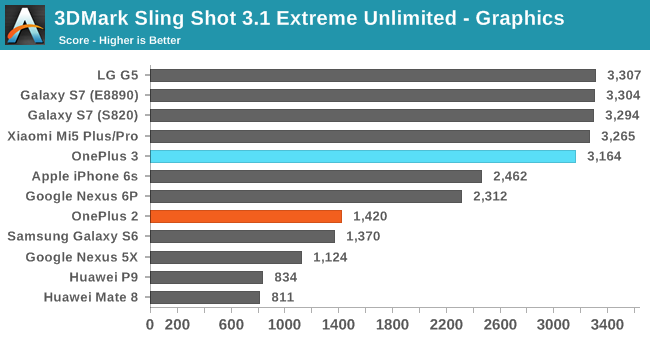
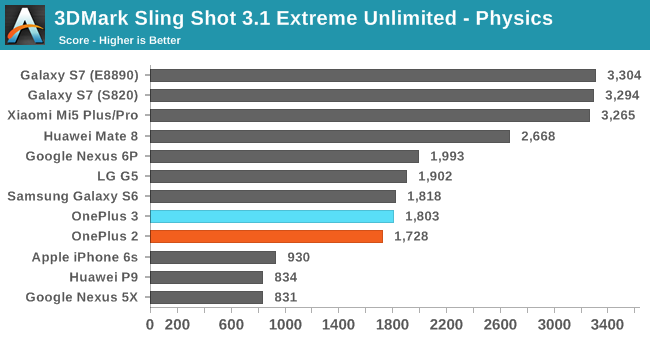
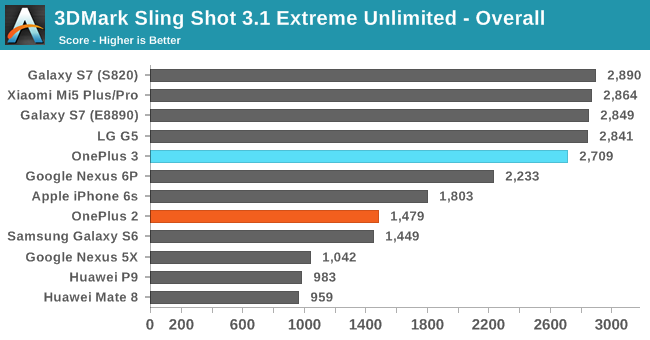
The OnePlus 3 does very well in 3DMark Sling Shot. In both the physics and graphics tests it trails the LG G5 slightly, but the gap isn't anything truly significant. Exynos 8890 is still not something I can compare to until our Galaxy S7 review is posted, but barring that it's clear that Snapdragon 820's Adreno 530 gives the fastest smartphone performance in this test, and when looking at the graphics performance the performance is over two times faster than the OnePlus 2.
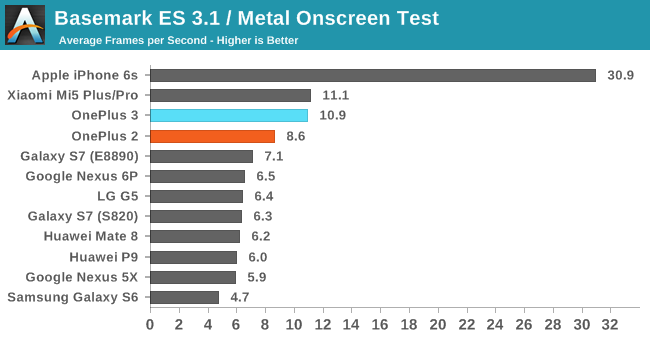
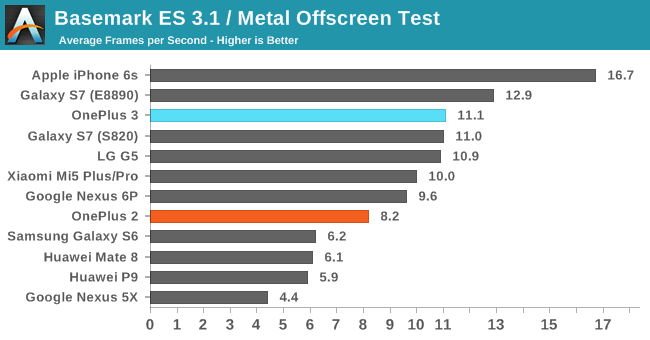
In BaseMark ES 3.1's on screen test the OnePlus 3 manages a significant lead over the LG G5 as a result of its lower resolution. In the off screen 1080p test both phones have essentially the same performance, which is what you'd expect. It looks like Adreno 530 doesn't make the same gains in this test that it does in some others, and it's not clear whether this is just the result of driver optimizations or something about the benchmark that is able to perform batter on other GPU architectures, which could be contributing to the iPhone's lead even in the off screen test.

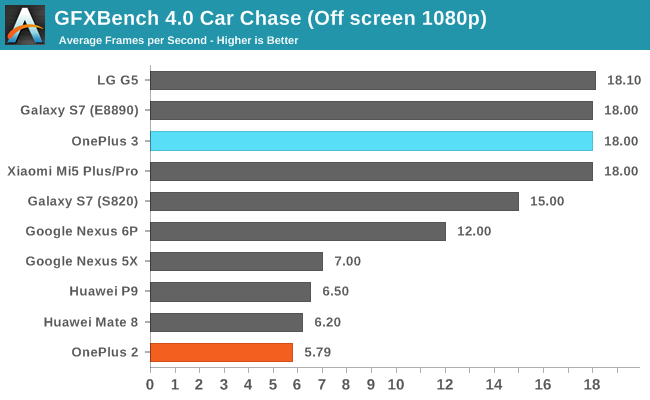
In GFXBench Car Chase the performance of the OnePlus 3 is in line with the LG G5. On screen performance is significantly higher due to the lower resolution display, while off screen performance at 1080p is about the same as the G5 and exactly the same as the on screen result. As far as absolute GPU performance goes, both of our Snapdragon 820 devices are at the top of the chart for absolute performance, and that's good news for anyone playing games or using software that benefits from a powerful mobile GPU.
NAND Performance
The OnePlus 3 moves to a UFS 2.0 NAND solution, which OnePlus claims is three times faster than the eMMC storage used in the OnePlus 2. In more realistic testing you probably won't end up achieving speeds three times faster than the OnePlus 2 since it actually wasn't slow at all by eMMC standards, but there should be a decent uplift in NAND performance nonetheless.
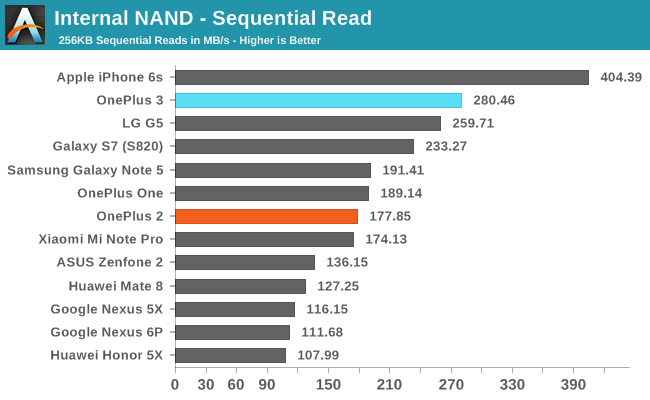
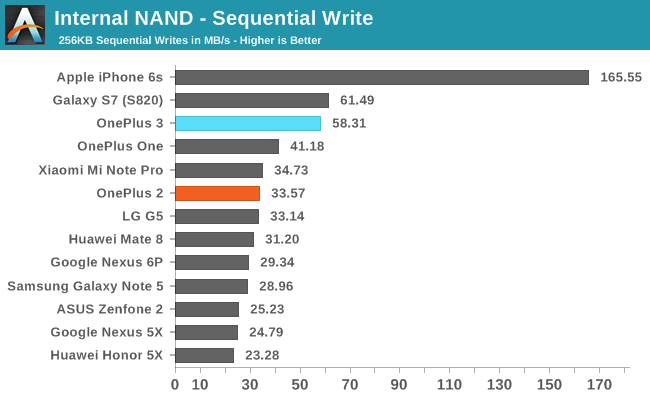
The move to UFS 2.0 brings healthy gains over the OnePlus 2's storage performance, although as I said, the OnePlus 2 didn't perform poorly at all by the standards of eMMC devices. Sequential read and write performance is actually the best that I've measured so far on an Android device. We're still not looking at anything close to what you get for sequential performance on iOS devices, but there are some other factors at play like the fact that the iPhone was a 128GB unit while our Android devices are usually 32GB or 64GB devices. In any case, the OnePlus 3 doesn't present any problems with storage performance, and you certainly won't run into the same issues that you can with budget smartphones at the $200-300 range where the eMMC solutions can be exceptionally slow.










176 Comments
View All Comments
PaulD87 - Monday, June 27, 2016 - link
It's hard to make an idea about phones by reading reviews on your site.Besides the fact that reading reviews that are 4 days apart you compare the benchmarked phones to totally different phones there are huge differences, for example:
Oneplus 3 review - Samsung galaxy 6 Display - Max Brightness: 335.0
Meizu PRO 5 reviews - Samsung Galaxy 6 Display - Max Brightness: 593.04
That's not a 1-5% let's say difference, that's the difference between a bad and a really good display.
Irishwomble - Thursday, June 30, 2016 - link
Brandon, currently a nexus 5 owner and just cracked the screen so should I get a oneplus 3 or nexus 5x? CheersUtilityMax - Friday, July 1, 2016 - link
Not, Brandon here, but just wanted to mention that a lot of US-based ebay vendors are having a blowout sale on the Nexus 5X phones, which are sold for as little as 225-240 USD for a new phone. It may be a sign that the inventories are cleared for a new 2016 Nexus smartphone. So even if Oneplus 3 is much better, specially if the newly released OTA fixes the screen accuracy issues, the Oneplus 3 will remain a 400USD phone, while the price of the Nexus 5X has gone down to the level of Moto G (2015), so the price performance is very good.AndyBandy - Tuesday, July 5, 2016 - link
Hi Brandon! Where did you place the color balance slider (from the display menu) when you measured the OnePlus 3 display calibration? Was it on the left side, or the on the right (the warmer side?)Vishalaestro - Saturday, October 1, 2016 - link
waiting for lenovo z2 plus review since it's way even cheaper than one plus 3 and has the same internals except camera.Ygor Cortes - Monday, February 20, 2017 - link
I really think that you should've used the phones' full potential (by turning low light features on (as HQ mode on the OnePlus 3 and HDR+ on the Nexus 5X and Nexus 6). You should've at least shown them on auto AND with the modes activated. Really good comparison though besides of that!